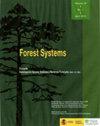Landsat系列地表温度在森林生态系统监测和分析中的应用:文献计量分析
IF 0.7
4区 农林科学
Q3 FORESTRY
引用次数: 1
摘要
研究目的:地表温度(LST)是森林生态系统监测和表征的重要变量。这个变量已经被地球资源卫星项目持续捕捉了近40年。目前的研究旨在查明利用陆地卫星获得的地表温度监测和分析森林生态系统的趋势、知识差距和机会领域。材料和方法:对1995-2020年Scopus检索的科学论文进行文献计量学分析。主要结果:所分析主题的出版物年增长率为22.58%。在该主题上发表文章最多的期刊是《SPIE学报》,其次是《遥感》。在这一主题上生产率最高的作者是C. Quintano、I. Vorovencii、O. E. Yakubailik和M. A. Zoran。关于各国的生产率,确定了38个国家发表了关于这一主题的出版物,其中生产率最高的是中国、美国和印度。这组国家也代表了国家间最坚实的合作网络。最常分析的森林生态系统是温带森林,其次是热带森林。关键词分析突出了遥感、NDVI、MODIS和蒸散发等主题。专题演变分析表明,地表温度数据的研究和解释领域与遥感领域同步发展。研究重点:陆地卫星地表温度分析是一个不断发展的主题,有可能有助于改善生态系统知识,并支持森林资源决策中的各种挑战。本文章由计算机程序翻译,如有差异,请以英文原文为准。
Application of Land Surface temperature from Landsat series to monitor and analyze forest ecosystems: A bibliometric analysis
Aim of study: Land surface temperature (LST) is an essential variable to monitor and characterize forest ecosystems. This variable has been consistently captured for almost four decades by the Landsat program. The current study aimed at identifying trends, knowledge gaps and opportunity areas in the use of Landsat derived LST for the monitoring and analysis of forest ecosystems.
Materials and methods: A bibliometric analysis of scientific articles indexed in Scopus in the period 1995-2020 was conducted.
Main results: Annual increase rate in the number of publications on the topic analyzed was 22.58%. The journal with more publications on the topic was Proceedings of SPIE, followed by Remote Sensing. The authors with the highest productivity on this topic were C. Quintano, I. Vorovencii, O. E. Yakubailik and M. A. Zoran. Regarding productivity by country, 38 countries with publications on this topic were identified, with the highest productivity located in China, USA and India. This group of countries also represented the most solid network of cooperation between countries. Forest ecosystems more frequently analyzed were temperate forests, followed by tropical forests. The analysis of keywords highlighted topics such as remote sensing, NDVI, MODIS and evapotranspiration. The analysis of thematic evolution indicated that areas of research and interpretation of LST data has evolved in parallel with remote sensing areas.
Research highlights: Landsat LST analysis is an evolving topic with potential to contribute to improve ecosystem knowledge and to support diverse challenges in forest resources decision-making.
求助全文
通过发布文献求助,成功后即可免费获取论文全文。
去求助
来源期刊

Forest Systems
FORESTRY-
CiteScore
1.40
自引率
14.30%
发文量
30
审稿时长
6-12 weeks
期刊介绍:
Forest Systems is an international peer-reviewed journal. The main aim of Forest Systems is to integrate multidisciplinary research with forest management in complex systems with different social and ecological background
 求助内容:
求助内容: 应助结果提醒方式:
应助结果提醒方式:


